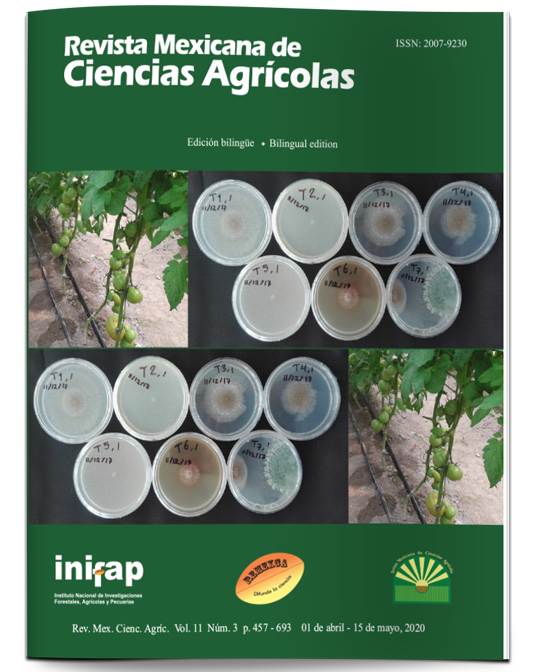Phenotypic diversity of chilli Amashito from Tabasco and Chiapas, Mexico
DOI:
https://doi.org/10.29312/remexca.v11i3.2087Keywords:
in situ, characterization, morphotypes, traditional knowledge, wild populationsAbstract
The objective of the work was to carry out the ethnobotanical exploration, collection and in situ characterization of populations of chilli Amashito (Capsicum annuum var. Glabriusculum) from the states of Tabasco and Chiapas. The work was carried out from July to December 2017 in 24 communities in the state of Tabasco and 15 communities in the north of the state of Chiapas, Mexico. Exploration sites were chosen based on the survey of key informants (recognized collectors), market information and available literature. A survey was applied to 39 collectors, one for each study site. The sample size to collect varied between 3 and 5 plants. Twenty morphological descriptors of plant, flower and fruit from 98 populations were measured in situ. The data were analyzed by means of principal component analysis and hierarchical clusters with the 13 variables that explained the greatest morphological variation. The collectors identify nine morphotypes of chilli Amashito that are distinguished mainly by color, pigmentation, shape and size of the fruit, and these grow mainly in ecosystems of cacao, acahual, banana and milpa farms. The first three main components explain 50.2% of observed morphological variation. The populations of chilli Amashito are differentiated and grouped according to the geographical characteristics of the study sites. The populations of the northern region of Chiapas were characterized by presenting elongated and larger fruits compared to those of the Tabasco communities. It was also found that in the neighboring areas where the two study regions converge, a group of populations that shared morphological similarities was distinguished.
Downloads
Published
How to Cite
Issue
Section
License
The authors who publish in Revista Mexicana de Ciencias Agrícolas accept the following conditions:
In accordance with copyright laws, Revista Mexicana de Ciencias Agrícolas recognizes and respects the authors’ moral right and ownership of property rights which will be transferred to the journal for dissemination in open access. Invariably, all the authors have to sign a letter of transfer of property rights and of originality of the article to Instituto Nacional de Investigaciones Forestales, Agrícolas y Pecuarias (INIFAP) [National Institute of Forestry, Agricultural and Livestock Research]. The author(s) must pay a fee for the reception of articles before proceeding to editorial review.
All the texts published by Revista Mexicana de Ciencias Agrícolas —with no exception— are distributed under a Creative Commons License Attribution-NonCommercial 4.0 International (CC BY-NC 4.0), which allows third parties to use the publication as long as the work’s authorship and its first publication in this journal are mentioned.
The author(s) can enter into independent and additional contractual agreements for the nonexclusive distribution of the version of the article published in Revista Mexicana de Ciencias Agrícolas (for example include it into an institutional repository or publish it in a book) as long as it is clearly and explicitly indicated that the work was published for the first time in Revista Mexicana de Ciencias Agrícolas.
For all the above, the authors shall send the Letter-transfer of Property Rights for the first publication duly filled in and signed by the author(s). This form must be sent as a PDF file to: revista_atm@yahoo.com.mx; cienciasagricola@inifap.gob.mx; remexca2017@gmail.
This work is licensed under a Creative Commons Attribution-Noncommercial 4.0 International license.



